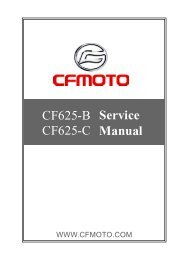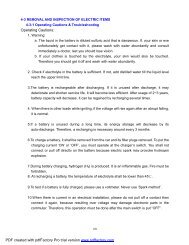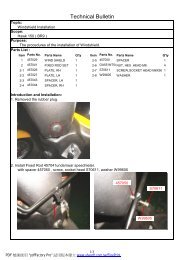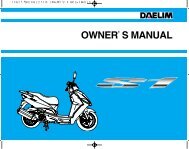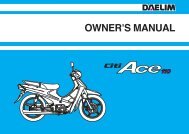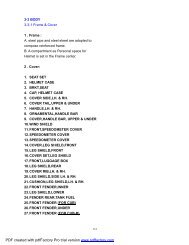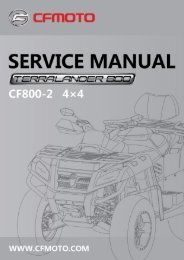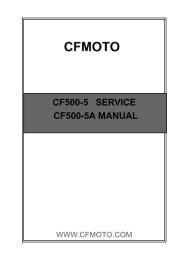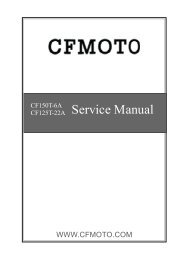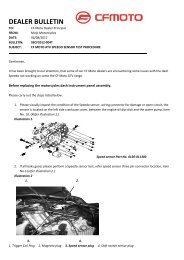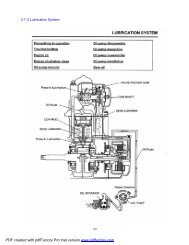Daelim B-Bone 125cc service manual.pdf - Mojo
Daelim B-Bone 125cc service manual.pdf - Mojo
Daelim B-Bone 125cc service manual.pdf - Mojo
You also want an ePaper? Increase the reach of your titles
YUMPU automatically turns print PDFs into web optimized ePapers that Google loves.
CHARGING SYSTEM<br />
16. CHARGING SYSTEM<br />
SERVICE INFORMATION·····16-1<br />
TROUBLESHOOTING······ 16-2<br />
BATTERY ···········16-3<br />
CHARGING SYSTEM INSPECTION· 16-4<br />
A.C. GENERATOR INSPECTION···16-5<br />
REGULATOR RECTIFIER INSPECTION·16-5<br />
SERVICE INFORMATION<br />
△! WARNING<br />
·Do not place flammable materials near battery when charging. This can be a fire hazard as hydrogen gas is created<br />
during charging battery.<br />
·Do not allow battery acid to come into contact with clothes, skin or eyes. Battery acid contact can cause burns or loss of<br />
eye sight. If contact occurs, thoroughly clean with water, and if acid enters eyes, flush with water and see a doctor.<br />
·If battery acid gets on clothing, as it can seep through or make a hole through the clothing and make its way to the skin,<br />
make sure to change clothing that has come into contact with battery acid and wash the battery acid from the clothes.<br />
△! CAUTION<br />
·This vehicle has a maintenance-free(MF) battery. Because MF batteries use different charging equipment, take special<br />
care when performing maintenance and especially when replacing parts. Not all regular battery equipment is<br />
compatible with MF batteries.<br />
·When charging the battery, remove the battery from the frame and do not open stopper.<br />
·There is the possibility of damaging the regulator/rectifier, etc. if the terminal or coupler is separated/connected when<br />
electricity is over flowing through the electrical devices. Make sure to turn the main switch OFF when performing<br />
maintenance to the charging equipment.<br />
● If the battery is allowed to repeatedly lose all its charge, is repeatedly over-charged, or if it is left in an un-charged state,<br />
the battery can be damaged, its life can be reduced, or it can lose some of its strength. It is important to note here that the<br />
battery will naturally last 2-3 years of normal use, and although it will re-charge, its load is reduced, leading to a loss in<br />
battery strength.<br />
● It is possible for the battery to become overcharged from battery body load. If a battery cell becomes short-circuited and<br />
if a state develops where voltage is not created between the terminals, the regulator will not operate and excessive<br />
voltage will develops where voltage is not created between the terminals, the regulator will not operate and excessive<br />
voltage will develop in the battery and normal cell electrolytes will decrease.<br />
● If the vehicle is not used for a long period, make sure to chage the battery every three months. If not so, the battery<br />
ability to store electricity is reduced.<br />
● For information on generator disassembly, refer to section 9.<br />
SPECIFICATIONS<br />
16<br />
BATTERY<br />
A.C.GENERATOR<br />
REGULATOR /<br />
RECTIFIER<br />
ITEM<br />
STANDARD VALUES<br />
Capacity<br />
12V - 10AH (MF)<br />
Terminal-to-terminal voltage (When fully charged)<br />
13.0 - 13.2V<br />
Charging coil resistance value ( 20°C )<br />
0.1 - 1.0Ω<br />
rpm at charging start<br />
1,500rpm<br />
Regulator voltage 14.5 0.5V<br />
TOOLS<br />
DIGITAL TESTER, PVA MULTI-TESTER, RPM TESTER, BATTERY TESTER<br />
16-1



